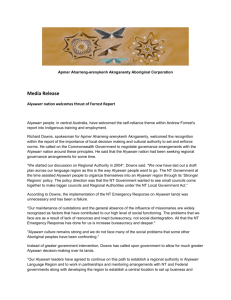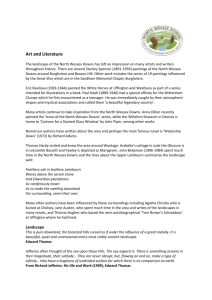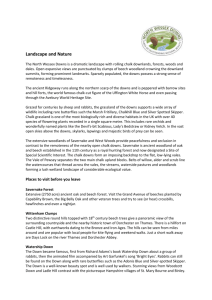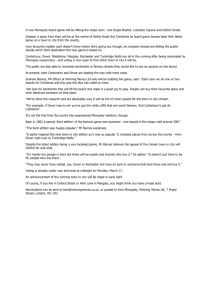JCA 119 North Downs - UK Government Web Archive
advertisement
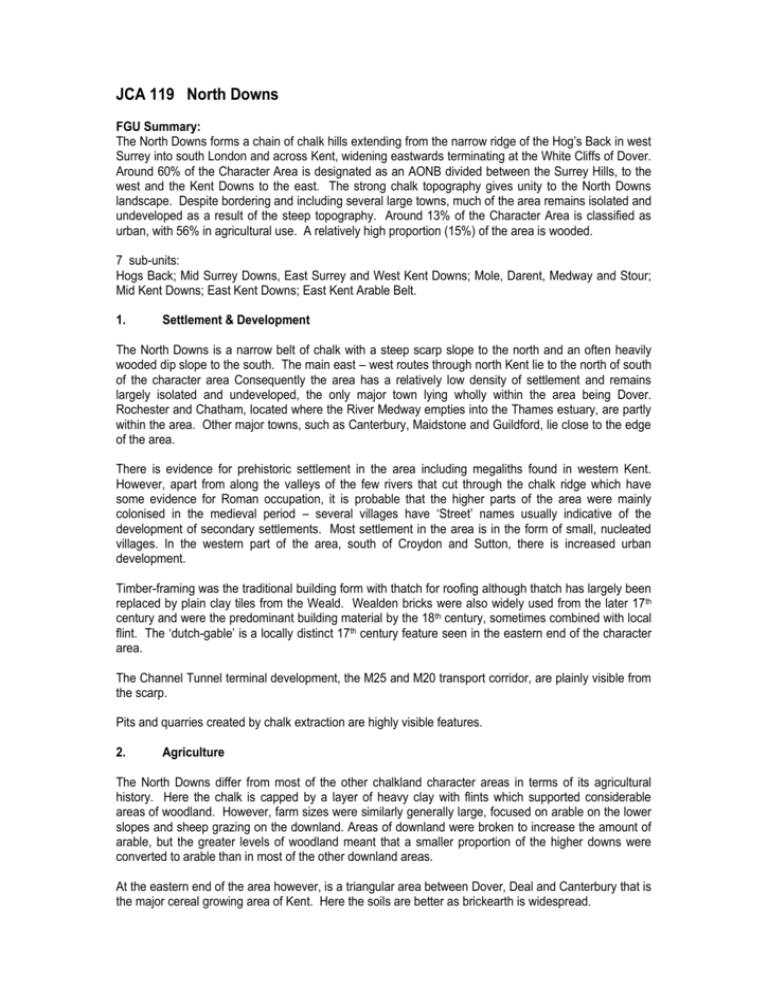
JCA 119 North Downs FGU Summary: The North Downs forms a chain of chalk hills extending from the narrow ridge of the Hog’s Back in west Surrey into south London and across Kent, widening eastwards terminating at the White Cliffs of Dover. Around 60% of the Character Area is designated as an AONB divided between the Surrey Hills, to the west and the Kent Downs to the east. The strong chalk topography gives unity to the North Downs landscape. Despite bordering and including several large towns, much of the area remains isolated and undeveloped as a result of the steep topography. Around 13% of the Character Area is classified as urban, with 56% in agricultural use. A relatively high proportion (15%) of the area is wooded. 7 sub-units: Hogs Back; Mid Surrey Downs, East Surrey and West Kent Downs; Mole, Darent, Medway and Stour; Mid Kent Downs; East Kent Downs; East Kent Arable Belt. 1. Settlement & Development The North Downs is a narrow belt of chalk with a steep scarp slope to the north and an often heavily wooded dip slope to the south. The main east – west routes through north Kent lie to the north of south of the character area Consequently the area has a relatively low density of settlement and remains largely isolated and undeveloped, the only major town lying wholly within the area being Dover. Rochester and Chatham, located where the River Medway empties into the Thames estuary, are partly within the area. Other major towns, such as Canterbury, Maidstone and Guildford, lie close to the edge of the area. There is evidence for prehistoric settlement in the area including megaliths found in western Kent. However, apart from along the valleys of the few rivers that cut through the chalk ridge which have some evidence for Roman occupation, it is probable that the higher parts of the area were mainly colonised in the medieval period – several villages have ‘Street’ names usually indicative of the development of secondary settlements. Most settlement in the area is in the form of small, nucleated villages. In the western part of the area, south of Croydon and Sutton, there is increased urban development. Timber-framing was the traditional building form with thatch for roofing although thatch has largely been replaced by plain clay tiles from the Weald. Wealden bricks were also widely used from the later 17th century and were the predominant building material by the 18th century, sometimes combined with local flint. The ‘dutch-gable’ is a locally distinct 17th century feature seen in the eastern end of the character area. The Channel Tunnel terminal development, the M25 and M20 transport corridor, are plainly visible from the scarp. Pits and quarries created by chalk extraction are highly visible features. 2. Agriculture The North Downs differ from most of the other chalkland character areas in terms of its agricultural history. Here the chalk is capped by a layer of heavy clay with flints which supported considerable areas of woodland. However, farm sizes were similarly generally large, focused on arable on the lower slopes and sheep grazing on the downland. Areas of downland were broken to increase the amount of arable, but the greater levels of woodland meant that a smaller proportion of the higher downs were converted to arable than in most of the other downland areas. At the eastern end of the area however, is a triangular area between Dover, Deal and Canterbury that is the major cereal growing area of Kent. Here the soils are better as brickearth is widespread. Medium concentrations of pre-1750 farmstead buildings. Farmsteads are often large with loose courtyard plans or attached buildings set around a yard creating a regular courtyard plan. Large timberframe barns, stables and cartsheds with later cattle accommodation make these complexes similar to those seen on some other chalkland areas such as the Hampshire Downs (JCA 130). This area has one of the main concentrations of timber-framed aisled barns in the country that stretches into the North Kent Plain and the Weald. 3. Fields and Boundary Patterns Fields across the area tend to have a degree of irregularity in their pattern and boundaries indicating a process of enclosure by agreement.. There is little evidence in the form of areas of regular fields for parliamentary type late enclosure. Generally field size tends to decrease towards the west with some very small square and rectilinear fields, often bounded by well-wooded hedges, intermixed with medium sized fields with curving boundaries. 4. Trees and Woodland The North Downs, and the west Kent and eastern Surrey area in particular, has a greater level of woodland cover than many other southern chalkland areas. Oak and ash are the predominant species on the higher slopes with beech, ash and maple on the typical of the dry valley sides. Much of the upper part of the scarp slope is covered by woodland or hawthorn scrub whilst in the west there are large areas of yew with box. Roads and tracks cutting across the scarp are usually lined with yew, wayfaring tree and whitebeam. 5. Semi-Natural Environments Unimproved chalk downland – species rich grassland. 6. River & Coastal Features Bisecting the Downs at Rochester, the river Medway is associated with busy transport routes, industry and mineral extraction which detract from the rural and unspoilt character. The Rivers Mole and Wey also cut narrow passages through the Downs at Leatherhead and Guildford. The east end of the character area represents the closest part of the country to continental Europe. Therefore this area has always been the first line of defence against invasion from France. Accordingly there is a highly significant sequence of military installations on this part of the coast dating from the medieval period including Dover Castle, Tudor forts, Napoleonic defences and WWII defences including many pill boxes and the command centre created within earlier tunnels at Dover Castle.
